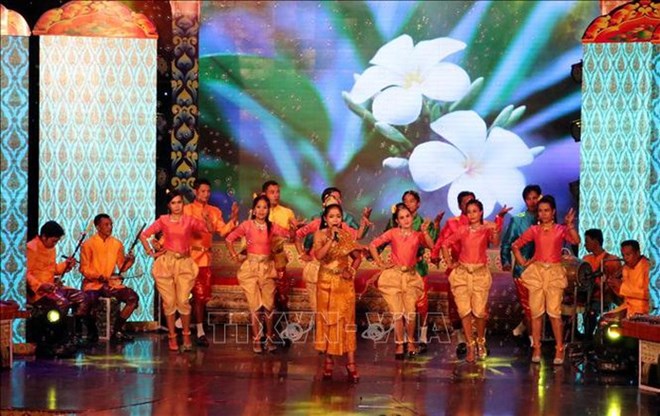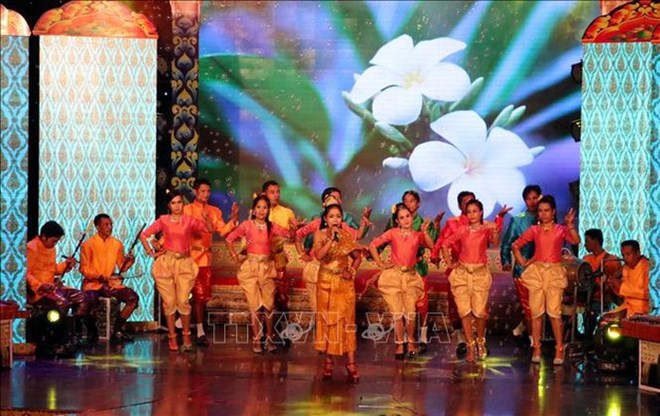
The first Khmer folk singing festival of the Mekong Delta region opened in Soc Trang province on October 1, drawing more than 300 contestants, mostly students, amateur artists and artisans from regional localities.

A performance at the festival (Photo: VNA)
The 96 performances at the festival were themed around the Party,
President Ho Chi Minh, as well as positive changes in several localities, the
love for homeland, traditional festivals, and family sentiments.
Following the opening ceremony, audiences were able to enjoy nine folk
performances.
Soc Trang is home to a large society of Khmer people. According to Nguyen Van
Bon, Director of the provincial radio and TV station and head of the organising
board, the event is a chance for amateur singers to share and exchange
experience to promote the traditional culture of Khmer people through folk
songs and musical instruments.
The festival is also an opportunity to honour, preserve, and develop the unique
art of the Khmer people, contributing to developing the cultural identities of
the group, while meeting the demand for folk art from locals and audiences from
other localities, he said.
The festival will run until October 5 in Studio 3 of the Soc Trang radio-TV
station. The opening and closing ceremonies are broadcast live on channels STV1
and STV2 of Soc Trang TV, as well as channel 5 of the Vietnam Television.
Source: VNA
With an increasingly vibrant and widespread emulation movement aimed at building cultured residential areas and cultured families, Yen Thuy District has been making steady progress toward improving both the material and spiritual well-being of its people, while fostering a civilized, prosperous, beautiful, and progressive community.
Once lacking recreational spaces and community facilities, Residential Group 2 in Quynh Lam Ward (Hoa Binh City) has recently received attention for the construction of a new, spacious, and fully equipped cultural house. The project followed the model of state support combined with public contributions in both labor and funding.
The "All people unite to build cultural life" movement, which has been effectively integrated with Kim Boi district’s socio-economic development goals, is fostering a lively spirit of emulation across local residential areas, hamlets, villages, public agencies, and enterprises. In addition, through the initiative, traditional cultural values are being preserved and promoted, while community solidarity and mutual support in poverty reduction and economic development are being strengthened.
A working delegation of the Hoa Binh provincial People’s Committee led by its Permanent Vice Chairman Nguyen Van Toan on June 11 inspected the progress of a project to build the Mo Muong Cultural Heritage Conservation Space linked to tourism services in Hop Phong commune, Cao Phong district.
Born and growing in the heroic land of Muong Dong, Dinh Thi Kieu Dung, a resident in Bo town of Kim Boi district, in her childhood was nurtured by the sweet lullabies of her grandmother and mother. These melodies deeply imprinted on her soul, becoming an inseparable part of her love for her ethnic group's culture. For over 20 years, this love for her hometown has driven Dung to research, collect, and pass down the cultural values of the Muong people to future generations.
In the final days of May, the Ethnic Art Troupe of Hoa Binh Province organized performances to serve the people in remote, mountainous, and particularly disadvantaged areas within the province. These were not just ordinary artistic shows, but they were the meaningful journeys aimed at spreading cultural values, enhancing the spiritual life of the people and contributing to the preservation of ethnic minority cultural identities.



